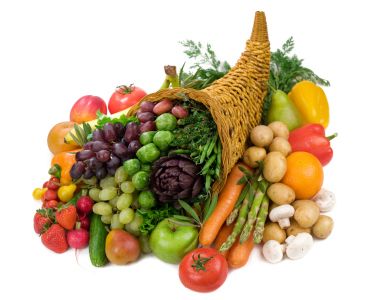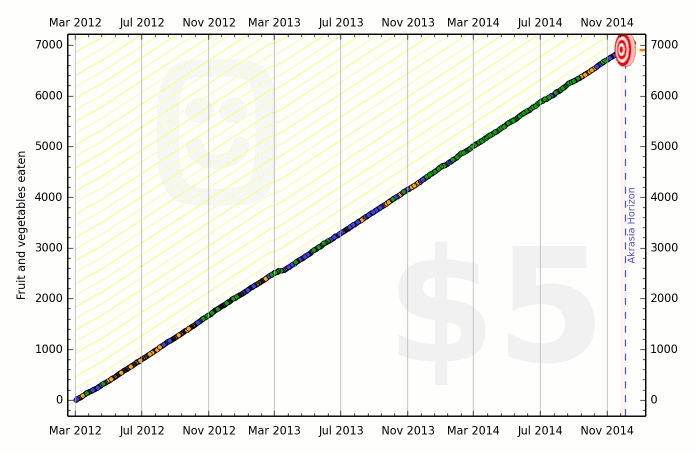
This is a guest post by Alice Harris, a programmer and long-time Beeminder enthusiast. Her previous Beeminder guest post — The One Must-Do Task Each Day — is one of our all-time favorites of this blog. Alys, as she’s known on the internet, is also a HabitRPG contributor who helped launch the new Beeminder-HabitRPG integration. We’ve been planning this post for many months (more on how in a subsequent post!) and are amazed that Alys has stuck to veggie-minding for 1000 days and counting.
Do you have trouble eating an appropriate amount of vegetables? Do you repeatedly buy them, then watch them wither and decay, feeling guilty about the waste of money and the impact on your health? Do you find healthy eating to be overwhelmingly complicated? I was like that for years. But for exactly one thousand days today, I have stuck to my goal of eating an average of seven servings of fruit and vegetables a day.
Behold its glory. The blip in the middle is from a short holiday in a location with an unreliable food supply, so this goal isn’t quite the perfect 7000 servings in 1000 days. I now bitterly regret that holiday!
Beeminder was essential of course. Before Beeminder, my best effort was a mere four days. When I discovered Beeminder I created a simple do-more goal with a rate of seven per day, and suddenly found that I just could not bear to let the goal fail.
The best advice I can give you though is not about Beeminder itself; it’s tips to help you make vegetable eating easier.
If you’ve done research into a healthy diet, you’ve probably seen a great deal of advice, some contradictory, that makes it all seem complicated and hard: eat a wide variety of vegetables, a wide range of vegetable colours, don’t include potatoes, DO include potatoes, include legumes but only one serving per day, eat cooked vegetables, eat raw vegetables, eat both cooked and raw vegetables, use some cooking methods but not others… Much of that advice is indeed very good, but for someone starting out, it’s just too much! So many things to consider, so many ways you might get it wrong — for a long time I found it so overwhelming I just gave up and didn’t try. So, my first tip: Ignore it all! For the first few months at least, just eat whatever kinds of fruits and vegetables you feel like, cooked (or not) in whatever way you can manage, and focus on nothing more than getting seven servings a day into your body. Don’t even worry about the fruit-to-vegetable ratio — if you have to eat four bananas in one day to make up your seven servings, do it! It’s still better than four chocolate bars. After you’ve become more used to eating vegetables, you’ll find it easier to expand your range, and your tastes will change so that you’ll enjoy them more. For now, just do the best you can without becoming stressed about it, and worry about improving the details later.
Also ignore well-meaning friends who tell you that eating properly is easy. It is — for them. If it were easy for you, you’d already be doing it. And keep in mind that it will be hard for you if you try to do it perfectly from the beginning, so don’t try! Initially, take the easiest, laziest path that you can while still meeting your goal. The first few months are about nothing but habit building and getting yourself used to vegetables.
“An approximation is good enough, especially if it will make you more likely to stick to your goal.”
To help with this, reduce any effort barriers. Is it hard to make time to go shopping for fresh produce? Find an online delivery website, perhaps even one that does regular weekly deliveries so that you can’t procrastinate about ordering your next box. Avoid peeling unless essential. Boil vegetables briefly in a very small amount of water or use a microwave steamer to lightly cook them. Many vegetables can be eaten raw, which is easiest of all and you might be surprised at how pleasant raw vegetables can be once you become used to them. Raw capsicums (bell peppers) are crunchy and sweet. Baby carrots are nature’s finger-food. Potatoes of course need to be thoroughly cooked, but even that can be done in a microwave — put in a whole potato by itself for five or ten minutes and it’s done. Make everything about vegetable preparation as simple as it can be for you.
What about accurately measuring serving sizes? Don’t try to do it accurately! An approximation is good enough, especially if it will make you more likely to stick to your goal. There are two easy ways to measure servings. If you are at home with scales at hand, use weight. If you are eating out, use volume. And there’s a clever trick for that, but first we’ll cover weight.
If you’ve done any research into serving sizes, you’ve probably seen a bit of variation in the recommended weights. For vegetables it’s usually about 75g to 80g per serving (I use 80g). For fresh fruit, it’s often either 80g or 150g per serving (I use 80g, for the simplicity of consistency with vegetables). For dried fruits you do need to use a different weight because they contain much less water than fresh fruit. A common recommendation is 30g but if you have trouble remembering that, just use 40g — exactly half the weight of a serving of vegetables. If you’re eating several fruits and vegetables at once, don’t try to measure them individually. Put them all on the scales together, and divide the total weight by 80 to get the number of servings.
When you can’t weigh your food (or can’t be bothered) use this easy volume trick: one serving of vegetables is about the size of your fist. At a restaurant, before you start eating, discreetly rest your fist by the side of your plate for a moment and do a rough comparison with the size of the vegetables. Remember the number for later or use the ingenious abacus bracelet to keep a tally (which is also discreet enough to do while socialising). The one exception is uncooked leafy green vegetables. If you poke at the pile of lettuce, you’ll see how much fresh air there is inside it. Because of this, one serving of lettuce is actually two closed fists. This volume meansurement trick is not perfect but it’s good enough! If you’re worried about cheating on your goal, you could deliberately underestimate a little.
“Discreetly rest your fist by the side of your plate for a moment and do a rough comparison with the size of the vegetables.”
Back in the early days of my veggieminding, I was meeting my goal each day, but procrastinating about it so much that I’d find myself having to eat the final few vegetables just before bedtime. When I became sick of this, I made it a rule that part of my morning routine is to prepare the day’s worth of vegetables. If it’s a work day I’ll pack a lunchbox with vegetables, mostly raw, cut into bite sized pieces so they are easy to eat. On a home day, I’ll fill a bowl with them and I’ll leave it on the kitchen table. Throughout the day I’ll snack on them whenever I’m in the vicinity. I can get through a full day’s supply without even noticing the effort of eating them.
Preparing them all in advance also helps enormously with measuring the vegetable servings. When you’ve filled up the lunchbox or bowl, weigh the whole thing and make note of it. As you are eating, put any uneaten parts back in the bowl (banana skins, apple cores). At the end of the day, weigh everything that’s left, subtract it from the first weight, and divide by 80g to get the number of servings eaten.
The most important thing to remember through all of this is that you don’t need to do this perfectly. As long as you’re eating better than you used to be, you’re doing just fine!
